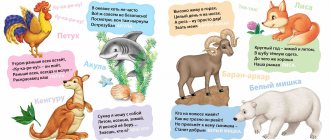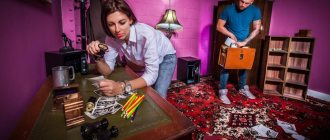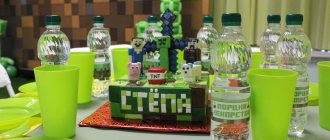Many children dream of visiting a fairy tale. It's interesting to feel like a fantasy hero. This is a reason to organize a quest for children, thanks to which they can find a treasure and feel like they are in a world of adventure. You can organize quests yourself. Next, we will look at how to organize quests for children 10-12 years old.
When children gather, they often don’t know how to have fun, what to do with themselves. They spend a lot of time near the computer or phone. The task of adults is to somehow diversify the lives of children. Organize their leisure time. Quests can be a great way to spend your time. But you can’t do without preliminary preparation of the event. The party organizer will have to find the details for completing the game and arrange the items in advance so that the quest participants can solve the riddles. Let's look at how to create a quest for children 10-12 years old.
Detailed description of the quest
♦ Age category: from 6 to 10 years (inclusive). ♦ Gender of the child: quest for girls. ♦ Travel time: up to 1 hour. But it also depends on the ingenuity of the participants, their number and age category. ♦ Purpose of the quest: ◊ search for a gift - after completing all the tasks, the participant(s) will find a treasured cache in which the quest organizer will hide the gift. The quest is perfect for giving a birthday gift or for playing at home. ◊ entertaining - the quest can be held as a separate competition or game in a house or apartment, to diversify the pastime of a group of children, the end result of which will also be the presentation of a gift or surprise. ♦ Venue: house, apartment, cottage or in any room in which the locations (hiding places) provided for in the quest coincide. ♦ Number of participants: up to 7 people ◊ single passage - solving the quest by one participant. ◊ group passage - several participants solve all the tasks together. ♦ Tasks: 11 tasks (ready-made task cards), based on stories from cartoons with Disney princesses. Tasks in the quest can be swapped, if necessary, shortened or removed that are not suitable. ♦ Necessary props: ◊ pencil (for writing quest answers); ◊ eraser (in case the answer is written incorrectly and the children want to correct it); ◊ printed quest materials on a color printer (12 cards (1 introductory card and 11 cards with tasks) ◊ 11 postal envelopes (but not necessary, tasks can simply be rolled up with a tube and tied with ribbon). ♦ Hiding places in the quest : ◊ Flower ; ◊ Chair; ◊ Phone; ◊ Book; ◊ Freezer; ◊ Glass; ◊ Wardrobe; ◊ Clock; ◊ Sofa; ◊ Battery; ◊ Oven. ♦ Genre: the quest requires active action in finding hiding places. After each solved riddle, you must look for the next one hiding place. Before the quest, the organizer places all the cards with tasks in the selected hiding places. ♦ Audience (for whom this quest is): the quest is perfect for girls aged 6 to 10 years and who can read and count within 10. ♦ The ready-made quest kit includes 3 PDF files: 1. The “Quest Instructions” file contains a list of necessary actions to prepare the quest for implementation, and detailed explanations (solution algorithm) for the tasks 2. The “Quest” file contains all the tasks that will need to be printed on a color printer , hide hiding places in places and decide for the participants. 3. The “Quest with answers” file contains the entire list of tasks with detailed answers. You don't have to print it out, just take note. ♦ Other quests on the site: ⇒ Quests up to 10 years old ⇒ Quests up to 16 years old ⇒ Quests from 18 years old
About the kit
- “Quest for girls 10, 11, 12, 13 years old at school or at home” includes a set of tasks, each of which is hidden in a specific place. The solution to each puzzle reveals the location where the next clue is hidden. Thus, a chain of tasks is obtained that must be completed step by step in order to find the cache with the hidden prize.
- The kit provides a wide variety of universal places in a school or apartment (private house, cottage) where you can hide tasks and a gift. 7 tasks out of 10 are additionally presented in the form of templates for self-editing. If some keywords do not fit, you can change them.
- The tasks can be laid out in any order and you can make any number of stages, and you can also choose the most convenient place for the final destination, where you want to hide the prize for completing the quest.
- The clues are colorfully designed and contain interesting and varied tasks based on word games and various types of ciphers.
- Recommended age for players: 10-13 years, but the set may be interesting for older girls.
- Please note: this set is a complete analogue of the March 8 Quest for teenagers at school or at home; they differ only in the postcards to start the game.
Using this kit you can organize a quest:
- for two or three teams: each type of task is completed in several versions, with different keywords - so that the teams have equal chances, and victory depends on the speed of reaction and intelligence of the players;
- for one player or for one team of players: in this case, the game organizer will have a wide choice of the most convenient places in the room to create a search chain; in each type of task, you need to select the option with the most suitable keyword.
View “Quest for girls 7, 8, 9 years old”
Quest plot
In a home quest with a search for a gift for girls, the beginning of the quest tells that all the fairy-tale princesses came to the aid of the little princess (quest participant) to help her find the treasured gift. We all know how much girls love princesses, and even more so, gifts! If you combine all this together - the search for a gift and your favorite Disney princesses, you will get an unforgettable fairy-tale journey that will further fill a birthday, a small party for girls, or transform and fill a simple gift giving with unforgettable impressions. Each hiding place in which a gift can be hidden is suggested by the princess with the help of a task. The quest contains 10 tasks and 10 Disney princess assistants: ◊ Princess Jasmine from the cartoon “Aladdin”; ◊ Snow White from the film “Snow White and the Seven Dwarfs”; ◊ Mulan from the movie “Mulan”; ◊ Princess Aurora from the film “Sleeping Beauty”; ◊ Ariel from the film “The Little Mermaid Ariel”; ◊ Cinderella from the film “Cinderella”; ◊ Pocahontas from the film “Pocahontas”; ◊ Princess Tiana from the film “The Princess and the Frog” ◊ Rapunzel from the film “Rapunzel”; ◊ Princess Belle from the film “Beauty and the Beast”.
Description of tasks in the quest
◊ “The First Flower” - an easy task - a text riddle, the answer to which leads to a hiding place. ◊ “Princess Jasmine's Helper” is a logical task in which you need to find two identical ones from a certain number of flowers, connect the letters and get a hiding place where a gift can be hidden. ◊ “Snow White's Helpers” - a task for attentiveness , each of the seven dwarves suggests the letter of the next hiding place, which must be put into a word. ◊ “Mulan's Assistant” is a letter-logical task in which in each group of pictures of objects you need to select a common letter and write it in a separate box, and from the collected letters add a secret word. ◊ “Assistant Aurora” - a colorful task for attentiveness, using paint colors, decipher the letters in the picture, and find the encrypted word. ◊ “Ariel's Helper” is a fairy-tale crossword puzzle about the cartoon characters about the little mermaid Ariel. ◊ “Cinderella's Helper” - magical riddles about the adventures of Cinderella. ◊ “Pocahontas's Assistant” is a mathematical task in which you need to find and count butterflies of different types, and after making additional calculations, guess the next location. ◊ “Tiana’s Assistant” is a creative task in which you need to find a rhyme among the presented pictures and suggested words. ◊ “Rapunzel's Assistant” - a task with a confusing labyrinth, find a way out of it, collecting letters and words along the way. ◊ “Princess Belle's Helper” is an attentiveness task in which you need to find a shadow for each presented character from the cartoon “Beauty and the Beast”, connect them with the shadow and add letters with serial numbers, thus finding out the next hiding place. The quest tasks were specially designed for children under 10 years old inclusive.
You can read reviews about our quests here “Reviews”.
Training “Bunker” material on psychology (grades 8, 9) on the topic
Role-playing game "Bunker"
Description of the game. Participants are given instructions: “A nuclear war has broken out on Earth. However, you were lucky, and at the time of the bombing you found yourself in a special bomb shelter - a sealed bunker. The explosion occurred very close to you, everything above was destroyed, no one was left alive, and the level of radiation is such that a person dies within a few minutes. However, your bunker has survived, and it contains enough air, food, water and fuel to survive a whole year. It is hoped that during this time the level of radiation on the surface will decrease so much that it will be possible to leave the bunker and begin to live as before. However, you do not know what is happening in other parts of the Earth. It is quite possible that all of humanity has perished, which means that it will be you, leaving the bunker in a year, who will have to found a new civilization.”
After this, the participants are given a list of the roles of those who find themselves in the bunker and asked to distribute them (it is better if the participants do this on their own, but if this fails within 2-3 minutes, they will have to resort to drawing lots).
Possible list of roles:
♦ Teenage girl, 14 years old, eighth grader. She studies well, is athletic, and beautiful. But she has an unstable nervous system, and the story of the atomic bombing left her in such shock that she only cries and cannot really say anything. She is in love with a boy who finds himself in a bunker (see role No. 2).
♦ Teenage boy, 16 years old, tenth grader. At school he had a reputation as a loser and a dunce, but he was physically healthy, strong and agile, and was involved in athletics. In love with a girl who also ended up in the bunker (see role No. 1).
♦ Girl, 19 years old, student at the theater institute. Charming and attractive, but she can’t do anything other than act on stage. She is expecting a child and is in her fifth month of pregnancy.
♦ Girl, 21 years old, final year student at a medical institute. However, she studied so-so, and it is not entirely clear whether she is ready to treat people on her own. He is interested in sewing.
♦ Male, 22 years old, student at the Institute of Physical Culture. Absolutely healthy, physically very strong. Has experience serving in the Ministry of Emergency Situations. However, he is prone to conflict behavior; he was fired from the Ministry of Emergency Situations for a fight in the workplace.
♦ Woman, 24 years old, psychologist. I was doing research and preparing to defend my dissertation. Has experience as a school teacher. Fluent in English.
♦ Male, 30 years old, military officer. Served in the Strategic Missile Forces, knows how to behave in order to survive an atomic bombing. Abuses alcohol.
♦ Woman, 34 years old, history teacher. He has a good knowledge of the history and culture of mankind, and knows how to raise and teach children.
However, she does not have her own children, and she is unlikely to be able to have them due to her health condition.
♦ Male, 51 years old, professor, nuclear physicist. In addition to his specialty, he is competent in a number of other technical fields (electronics, construction, communication systems). Recently he has often complained of severe pain in the heart area.
♦ Woman, 60 years old, agronomist. Knows how to organize agricultural production even in unfavorable conditions. He is interested in cooking.
If the presenter wants to modify or expand this list, then it should be remembered that there should be no weak, obviously “losing” roles. For each role, some quality should be provided that is valuable for the situation indicated in the game. Such a “trump card” can be youth and health, expecting a child, the presence of knowledge and skills important for survival, a high degree of mastery of the cultural and technical heritage of mankind, etc. At the same time, the more valuable this quality is, the more important it is to provide for some “weak link”, counterbalancing the dignity of the first (health problems, tendency to alcoholism, quarrelsome character, etc.).
When the roles are assigned, the second part of the instructions is given: “But suddenly it turned out that things in your bunker are not so good - you felt a sharp lack of oxygen, it became difficult to breathe. It turns out that the air supply system in a bomb shelter is designed for fewer people than were in it! This means that someone will have to sacrifice, otherwise everyone will suffocate and die painfully... Choose those who will have to leave the bunker to the surface, to certain death. Remember: those who are most important to building a new civilization should ultimately remain in the bunker. However, each of you, naturally, wants to survive on his own and will not voluntarily offer his candidacy for leaving the bunker, but, on the contrary, will try to prove that he is important for the future civilization and deserves to survive! However, if the group cannot be convinced of this, he will be forced to leave the bunker and die. You have 5 minutes to make a decision, then your oxygen supply will be depleted and you will begin to choke.”
When determining how many places there will be in a bunker and, accordingly, how many people should be excluded, it is recommended to use the following table as a guide.
Number of participants in the game/Number of places in the “bunker”
6/4
7-8/5
9-10/6
11-12/7
When more than 12–13 teenagers participate in the game, it is better not to add new roles, but to divide the group into two subgroups and play them in parallel, offering them the same list of roles. At the discussion stage, it will be interesting to compare who was chosen by representatives of different subgroups and what guided them in doing so.
Participants are given 5 minutes to discuss and make a decision. At this time, the presenter can additionally “escalate the situation” - for example, turn off the lights (“There are problems with the power supply in the shelter”), unexpectedly loudly bang his fist on the table (“Something exploded on the surface”), etc. If after 5 For minutes the group still hasn’t decided who should leave the bunker, the leader reminds that it is becoming increasingly difficult to breathe because the air in the shelter is running out, and gives another 2-3 minutes for discussion. If after this the group has not reached a consensus, then the discussion stops and the participants who must leave the bunker are determined by open voting.
Psychological meaning of the game. Developing the ability to defend one’s interests using various methods of influence, as well as group interaction skills. In addition, the game encourages participants to think about their value orientations.
Discussion. Which inhabitants of the bunker survived, and which were “sent to the next world”? Each choice needs to be justified. What influence techniques were used by the participants to defend their positions? Was it manipulation or were methods such as argumentation and request used? ♦ Teenage girl, 14 years old, eighth grader. She studies well, is athletic, and beautiful. But she has an unstable nervous system, and the story of the atomic bombing left her in such shock that she only cries and cannot really say anything. She is in love with a boy who finds himself in a bunker (see role No. 2).
♦ Teenage boy, 16 years old, tenth grader. At school he had a reputation as a loser and a dunce, but he was physically healthy, strong and agile, and was involved in athletics. In love with a girl who also ended up in the bunker (see role No. 1).
♦ Girl, 19 years old, student at the theater institute. Charming and attractive, but she can’t do anything other than act on stage. She is expecting a child and is in her fifth month of pregnancy.
♦ Girl, 21 years old, final year student at a medical institute. However, she studied so-so, and it is not entirely clear whether she is ready to treat people on her own. He is interested in sewing.
♦ Male, 22 years old, student at the Institute of Physical Culture. Absolutely healthy, physically very strong. Has experience serving in the Ministry of Emergency Situations. However, he is prone to conflict behavior; he was fired from the Ministry of Emergency Situations for a fight in the workplace.
♦ Woman, 24 years old, psychologist. I was doing research and preparing to defend my dissertation. Has experience as a school teacher. Fluent in English.
♦ Male, 30 years old, military officer. Served in the Strategic Missile Forces, knows how to behave in order to survive an atomic bombing. Abuses alcohol.
♦ Woman, 34 years old, history teacher. He has a good knowledge of the history and culture of mankind, and knows how to raise and teach children.
However, she does not have her own children, and she is unlikely to be able to have them due to her health condition.
♦ Male, 51 years old, professor, nuclear physicist. In addition to his specialty, he is competent in a number of other technical fields (electronics, construction, communication systems). Recently he has often complained of severe pain in the heart area.
♦ Woman, 60 years old, agronomist. Knows how to organize agricultural production even in unfavorable conditions. He is interested in cooking.









